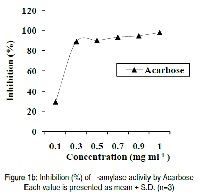α-Amylase and α-Glucosidase inhibitory activity assessment of Cucurbita maxima seeds – a LIBS based study
Keywords:
Cucurbita maxima, α-amylase, α-glucosidase, in vitro antidiabetic, LIBSAbstract
The aim of the present study was to investigate, α-amylase and α-glucosidase inhibitory activities of the aqueous extract of Cucurbita maxima seeds in vitro and to correlate their activity with their phytoelemental profile quantitatively assessed by Laser-Induced Breakdown Spectroscopy (LIBS). Diabetes can be managed by controlling postprandial hyperglycemia which can be achieved by inhibiting carbohydrate hydrolyzing enzymes like α-amylase and α-glucosidase. Results reveal that the C. maxima seeds have appreciable α-amylase inhibitory activity of 46.03±1.37% with IC50 value at 7.00±0.29 mg ml-1 in addition to substantial α-glucosidase inhibitory effect of 35.11±1.04% with IC50 at 8.11±0.36 mg ml-1. Acarbose was used as a reference. LIBS analysis showed the presence of certain phytoelements viz. Mg, Ca, K and Na which are well known glycemic elements and hence could be responsible for inhibitory activity of carbohydrate hydrolyzing enzymes.Thus, α-amylase and α-glucosidase inhibitory action of C. maxima seeds would be responsible for their antidiabetic activity. The glycemic elemental profile further validates their role in controlling diabetes and hence C. maxima seeds could be explored as a potential herbal candidate for managing postprandial hyperglycemia causing type 2 diabetes mellitus.
References
. YaoY, Sang W, Zhou M and Ren G. Antioxidant and α-glucosidase inhibitory activity of colored grains in China. J Agric Food Chem.2010; 58:770-774.
. Shimabukuro M,Higa N, Chinen I, Yamakawa K and Takasu N. Effects of a single administration of acarbose on postprandial glucose excursion and endothelial dysfunction in type 2 diabetic patients: a randomized crossover study, J ClinEndocrinolMetab.2006; 91:837-842.
. Van de Laar FA, Lucassen PL, Akkermans RP, van de Lisdonk EH, Rutten GE and van Weel C. α-Glucosidase inhibitors for patients with type 2 diabetes: results from a Cochrane systematic review and meta-analysis. Diabetes Care.2005; 28:166-175.
. Rai PK, Srivastava AK, Sharma B, Dhar P, Mishra AK and Watal G. Use Of laser-Induced Breakdown spectroscopy for the detection of glycemic elements in Indian medicinal plants. Evid Based complement alternat med. 2013;1:1-9.
. Kushawaha DK, Yadav M, Chatterji S, Maurya GS, Rai AK and Watal G. Free radical scavenging index of Cucurbita maxima seeds and their LIBS based antioxidant elemental profile. Int J Pharm Pharm Sci.2016; 8:344-350.
. HanamuraT, Hagiwara T and Kawagishi H. Structural and functional characterization of polyphenols isolated from acerola (Malpighiaemarginata DC.) fruit. BiosciBiotechnolBiochem.2005; 69:280-286.
. Whitaker TW and Bemis WP. Origin and evolution of the cultivated Cucurbita. Bull Torrey Bot Club.1975; 102:362-368
. Kirtikar KR and Basu BD. Indian medicinal plants,Oriental Enterprises., Dehradun, (2003). pp. 1606-8
. Shaheen SJAA, Kaskoos RA, Hamad KJ and Ahamad J.In-vitro antioxidant and α-amylase inhibition activity of Cucurbita maxima. J PharmacognPhytochem.2013; 2:121-124.
. Mccue P and Shetty K. Inhibitory effects of rosmarinic acid extracts on porcine pancreatic amylase in vitro.Asian Pac J ClinNutr. 2004;13:101-106.
. Kim YM, Jeong YK, Wang MH and Rhee HI. Inhibitory effect of pine extract on α-glucosidase activity and postprandial hyperglycemia. Nutrition. 2005; .21:756-761.
. Shukla S, Rai PK, Chatterji S, Rai NK, Rai AK and Watal G. LIBS Based Screening of Glycemic Elements of Ficusreligiosa. Food Biophys.2012; 7:43-49.
. Hasani-Ranjbar S, Larijani B and Abdollah M. A systematic review of Iranian medicinalplants useful in diabetes mellitus. Arch Med Sci. 2008; 4:285‑292.
. Saha P, Bala A, Kar B, Naskar S, Mazumder UK, Haldar PK and Gupta M. Antidiabetic activity of Cucurbita maxima aerial parts. Res J Med Plant.2011; 5:577-586.
. Wang Y, Ma L, Li Z, Du Z, Liu Z, Qin J, Wang X, Huang Z, Gu L and Chen ASC. Synergetic inhibition of metal ions and genistein on α-glucosidase. FEBS letters.2004; 576:46-50.
. Rai NK, Rai PK, Pandhija S, Watal G, Rai AK and Bicanic D. Application of LIBS in detection of antihyperglycemic trace elements in Momordicacharantia. Food Biophys. 2009;4:167-171.
. Suvd D, Fujimoto Z, Takase K, Matsumura M and Mizuno H. Crystal Structure of Bacillus stearothermophilus α-Amylase: Possible Factors Determining the Thermostability. J Biochem.2001; 129:461-468.
. Saboury AA and Karbassi F. Thermodynamic studies on the interaction of calcium ions with alpha-amylase. ThermochimicaActa.2000; 362:121-129.
. Zhang X, Zhang X, Shi L, Li X, Sheng Q, Yao L, Shen D, Lü ZR and Zhou HM. Effect of Ca2+ on the activity and structure of a-glucosidase: Inhibition kinetics and molecular dynamics simulations. J BiosciBioeng.2014; 117:696-705.
. Kumar NM, Karthikeyan S and Jayaraman G.Thermostable alpha-amylase enzyme production from Bacillus laterosporus: Statistical optimization, purification and characterization.BiocatalAgricBiotechnol.2013; 2:38-44.
Saupi N, Zakira MH and Bujang JS. Analytic chemical composition combination and mineral content of yellow velvet leaf (Limnocharisflava L. Buchenau). J Appl Sci.2009; 9:2969-2974.



